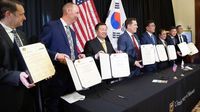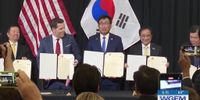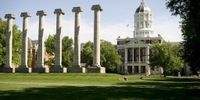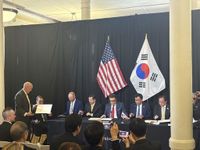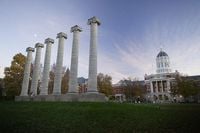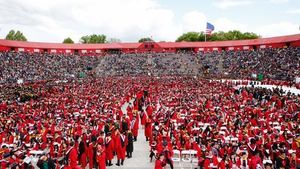COLUMBIA, Mo. (KMIZ) — On April 16, 2025, the University of Missouri (MU) announced a significant partnership with several South Korean firms to advance its NextGen nuclear research reactor project. This collaboration involves Hyundai Engineering America, the Korea Atomic Energy Research Institute (KAERI), the Hyundai Engineering Company, and MPR Associates, marking a pivotal step in the development of a new state-of-the-art reactor designed to enhance cancer treatment capabilities.
The agreement, valued at $10 million, will initiate the design and licensing phase of the NextGen reactor, which is projected to cost over $1 billion and take approximately 8 to 10 years to complete. Located on Discovery Ridge in south Columbia, the new reactor is expected to be operational within the next decade, doubling the output capacity of the current facility.
University of Missouri President Mun Choi emphasized the historic nature of this initiative, stating, "NextGen MURR represents our commitment to research that changes lives. It will allow Mizzou to lead the nation in producing critical medical isotopes while opening new frontiers in science, engineering, and patient care." The existing reactor, known as MURR, has been operational for nearly 60 years and is currently the most powerful university research reactor in the United States, operating at 10 megawatts.
Executive Director of the University of Missouri Research Reactor, Matt Sanford, noted that the new reactor will incorporate lessons learned from MURR's long history. He stated, "The new reactor will be larger, more powerful, and more versatile." The NextGen reactor will operate at 20 megawatts, effectively tripling the university's radioisotope output, which is crucial for cancer treatments.
As the only producer of Lutetium-177 in the United States, MU plays a vital role in the global supply of medical isotopes used in cancer therapies. In the past year alone, the current reactor assisted 450,000 cancer patients across the nation. With the demand for radioisotopes rising due to advancements in precision diagnostics and targeted therapies, the NextGen reactor aims to secure a domestic supply and further enhance research capabilities.
The project has garnered significant financial backing, with $200 million already secured, including $50 million from Governor Mike Kehoe's state budget. Choi expressed confidence that despite potential challenges, including federal funding uncertainties, the university will receive the necessary support to advance this initiative. He remarked, "At this point, we’re just exchanging intellectual property; there are no physical assets being shipped from South Korea to the United States."
Local officials view the reactor's development as a means to attract economic growth and medical research initiatives to Columbia. Todd Graves, Chair of the University of Missouri Board of Curators, highlighted the project's potential impact on Missouri's economy and its role in advancing medical isotope research. He stated, "This project will be economic development for this state on this level of scientific discovery, a level of high-level manufacturing that we will enjoy for many years to come."
The partnership with the South Korean consortium is particularly significant, as it marks the first U.S.-based nuclear reactor project for the Korean firms involved. Hyundai Engineering has prior experience in nuclear production, having collaborated with a firm in Michigan earlier this year on small modular reactors.
The initial phase of the NextGen MURR project will involve detailed programming studies and a preliminary site evaluation to establish initial project costs and timelines. The results from this phase will feed into the preliminary design and licensing efforts, overseen by the Board of Curators and MU leadership.
In addition to the new reactor, MU recently announced a $20 million expansion to its existing MURR facility, which will add 16,000 square feet of space dedicated to innovative research and medical isotope production. This expansion aims to further enhance the university's capabilities in nuclear medicine and collaborative projects with industry partners.
Missouri's leadership is also pushing to expand the state's nuclear capacity more broadly. The governor's office and the Department of Natural Resources are co-leading an in-state nuclear summit to explore new sources of reliable energy. Kurt Schaefer, director of the Missouri Department of Natural Resources, expressed optimism about the state's nuclear future, stating, "We look forward to working with NGA and DOE to move both Missouri and the country forward in advancing nuclear energy."
As the NextGen MURR project progresses, it is poised to solidify Missouri's position as a national hub for innovation in nuclear health technologies, ultimately benefiting countless patients in need of life-saving treatments.
